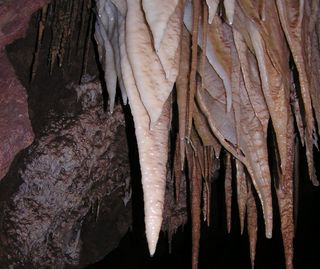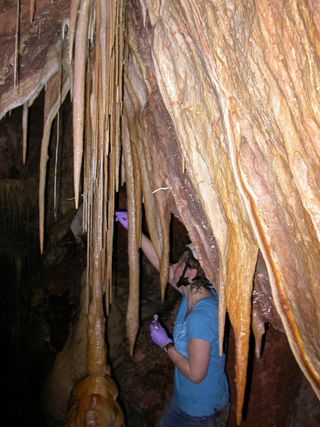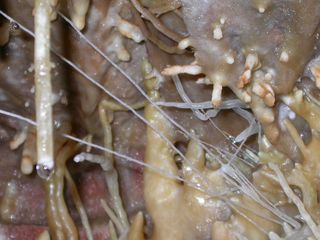
Bizarre Microbes Discovered in Desert Cave

Tucked beneath the desert in southern Arizona is Kartchner Caverns, a maze of remote, largely uninhabited underground passages and caverns that are cloaked in perpetual darkness. But this seemingly desolate cave system actually plays host to a surprisingly diverse array of microbes that survive underground despite the extreme dearth of light and nutrients, according to a new study.
A team of researchers led by scientists at the University of Arizona in Tucson discovered communities of microorganisms that live in the limestone caves of Kartchner Caverns State Park. These microbial ecosystems thrive by teasing out the limited nutrients in water runoff that drips into the cave through cracks in the cave's rocky exterior, the researchers said.
The unexpected discovery, published online Sept. 12 in the journal of the International Society for Microbial Ecology, could help scientists understand how bacteria, fungi and other microbes survive in extreme environments. [Extreme Life on Earth: 8 Bizarre Creatures]
"We didn't expect to find such a thriving ecosystem feasting on the scraps dripping in from the world above," Julie Neilson, an associate research scientist in the University of Arizona's College of Agriculture and Life Sciences, said in a statement. "What is most interesting is that what we found mirrors the desert above: an extreme environment starved for nutrients, yet flourishing with organisms that have adapted in very unique ways to this type of habitat."
A different environment
Living in darkness, the underground microbes are unable to carry out photosynthesis— the process that plants and other organisms use to convert sunlight into energy. Still, the types of microorganisms found in Kartchner Caverns shared similarities to the more familiar types found on the Earth's surface, the researchers said.

"We discovered all the major players that make up a typical ecosystem," Neilson explained. "From producers to consumers, they're all there, just not visible to the naked eye."
Sign up for the Live Science daily newsletter now
Get the world’s most fascinating discoveries delivered straight to your inbox.
Even without such biodiversity, simply living off the water dripping into Kartchner Caverns is an impressive feat, as there is a shortage of organic carbon — one of the building blocks of life on Earth — within the cave.
"Kartchner is unique because it is a cave in a desert ecosystem," Neilson said. "It's not like the caves in temperate areas such as in Kentucky or West Virginia, where the surface has forests, rivers and soil with thick organic layers, providing abundant organic carbon. Kartchner has about a thousand times less carbon coming in with the drip water."
These cave-dwelling microorganisms cultivate what little nutrients and energy are locked in the water molecules from decaying organic matter in the soil above ground, or from minerals dissolved in the rock fissures, the researchers said. The microbes have adapted means of using the chemical compounds present in the cave — in some cases, even eating rock to get energy from compounds such as manganese or pyrite, Neilson said. [7 Theories on the Origin of Life]
"Instead of relying on organic carbon, which is a very scarce resource in the cave, they use the energy in nitrogen-containing compounds like ammonia and nitrite to convert carbon dioxide from the air into biomass," she said.

Finding microbes underground
To reveal the cave's hidden microbial communities, the researchers swabbed stalactites and other formations hanging from the ceiling of Kartchner Caverns for DNA analysis. The genes found in these samples were used to reconstruct bacteria and archaea — single-celled microorganisms without a cell nucleus — that live in the limestone recesses.
Earlier studies indicated that stalactites act as islands for cave microbes, meaning there is little mixing between populations of microorganisms on different cave formations.
From their DNA analysis, the researchers not only encountered a diverse range of organisms that make up a complex food web within the cave, they also stumbled on some microbes that were likely previously unknown to science.
"Twenty percent of the bacteria whose presence we inferred based on the DNA sequences were not similar enough to anything in the database for us to be able to identify them," Neilson said. "On one stalactite, we found a rare organism in a microbial group called SBR1093 that comprised about 10 percent of the population on that stalactite, but it represented less than 0.5 percent of the microbes on any of the others."
The organism's DNA sequence has only been found three times in history: in a type of sedimentary rock in the salty waters of Shark Bay in Australia; in a site contaminated with hydrocarbons in France; and in a sewage treatment plant in Brisbane, Australia, Neilson said.
"This suggests there are many microbes out there in the world that we know almost nothing about," she added. "The fact that these organisms showed up in contaminated soil could mean they might have potential for application such as environmental remediation."
Studying these types of microbes can help scientists understand their resilience in extreme environments, which could have applications in the search for life on other planets as well.
"When you think about exploring Mars, for example, and you look at all those clever strategies that microbes have evolved and tweaked over the past 4 billion years, I wouldn't be surprised if we found them elsewhere if we just keep looking," study principal investigator Raina Maier, a professor in the University of Arizona's department of soil, water and environmental science, said in a statement.
Follow Denise Chow on Twitter @denisechow. Follow LiveScience @livescience, Facebook & Google+. Original article on LiveScience's OurAmazingPlanet.

Denise Chow was the assistant managing editor at Live Science before moving to NBC News as a science reporter, where she focuses on general science and climate change. Before joining the Live Science team in 2013, she spent two years as a staff writer for Space.com, writing about rocket launches and covering NASA's final three space shuttle missions. A Canadian transplant, Denise has a bachelor's degree from the University of Toronto, and a master's degree in journalism from New York University.
Most Popular


